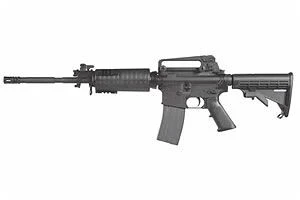Bushmaster Gas Piston 90294 vs Springfield Armory Model 1873
Put rifles head to head to compare caliber and more.
|
$1110.50
|
vs |
$5.00
|
| Rifles | Bushmaster Gas Piston 90294 | Springfield Armory Model 1873 |
|---|---|---|
| Summary | ||
| Rating | ||
| Rank | ||
| Action | Semi-Automatic | |
| Caliber | .223 Remington | |
| Details | ||
| Brand | Bushmaster | Springfield Armory |
| Reviews | See 2 Reviews | N/A |
| Prices | ||
| MSRP | $1,081.50 | $6.00 |
| Used Price | $757.05 | $4.20 |
| Sale Price | $973.35 | $5.40 |
Rifles Descriptions
Bushmaster Gas Piston 90294
The Bushmaster Gas Piston System Rifles bring new levels of reliability to the “AR” type rifle platform by eliminating carbon build up, gas leaks and heat within the Upper Receiver. The Gas Piston System operates by tapping gas pressure off the barrel much like the systems found on AK-47s and FALs * Functions with a wider range of ammunition - less gas pressure - lower cyclic rate * Offers improved reliability and control - with cleaner operation and reduced recoil * Keeps carbon build up and powder residue from reaching - and fouling the Upper Receiver and Bolt Carrier * A Detented Plug in the Gas Block allows easy cleaning of the Systems’ Hard Chrome Plated Piston
Springfield Armory Model 1873
The Springfield Model 1873 was the Army’s standard issue rifle during the Indian Wars of the 1870s and 1880s. The rifle also saw service in the Spanish-American War and the Philippine Insurrection. Today, it is a favorite weapon of gun collectors. The origins of the M1873 Springfield date back to the waning days of the Civil War. Erskine S. Allin, the master armorer at the Springfield Armory in Massachusetts, was tasked with converting the Army’s muzzle-loading rifles into breech loaders. This resulted in the development of the Model 1865 Springfield, known as “Allin’s Alteration” and later the “Needle Gun” for its long firing pin. The M1865 used a copper-cased cartridge which propelled a .58 caliber bullet with sixty grains of powder. Allin modified his design by lowering the caliber from .58 to .50 after a series of trials in 1866, resulting in the Model 1866. On the frontier, the M1866 performed admirably during several engagements with Indian warriors, and it gained a reputation as a dependable firearm. However, there were flaws in its design, most notably, the breech block tended to swing open when under pressure. Eager to correct this flaw, the Ordnance Department began a series of trials to find a suitable replacement to the M1866.



